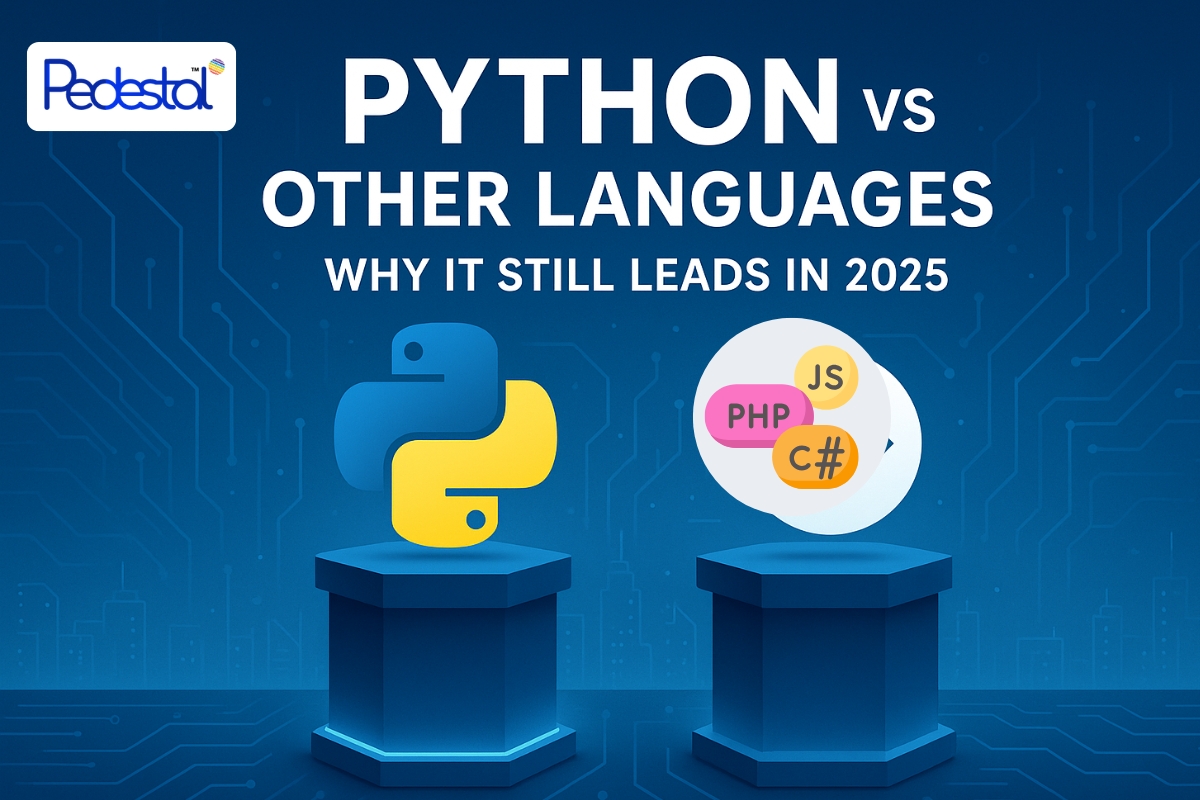In 2025, Python is still by far the most popular language for students and professionals alike. There are many reasons for Python’s popularity: an easy to learn structure, multiple project formats and a vibrant community. It is a clear winner compared to any language, such as Java, JavaScript, C++ and Go. Taking a Python certification course can help build skills that employers will admire. This blog shares the top reasons, why Python is still number one in 2025 and how it compares to the other languages. Let’s take a look at what makes Python so great.
Python is Simple for Beginners
Python is loved by many, because it is pretty simple to understand. You will find that coding on Python almost reads like plain English. You won’t ever need to memorize difficult rules to write the code. It will only take one line of code to complete a program that displays a message, whereas you will need 4 or 5 lines of code in Java just for that task. This all comes together to make Python a great language for students starting out in programming. You are able to create projects without feeling overloaded with knowledge.
In 2025, Python’s simple style continues to make it popular. Educating beginners in coding is much easier because they can begin building things like small games or apps without becoming bogged down in details, as with some other programming languages. JavaScript can be more challenging for beginners irrespective of their background because it is usually meant for Web pages and requires students to deal with more complex ideas, such as active user interactions. And if JavaScript is tough, then Compare C++ – students have to manage the computer’s own memory. Python allows students to think about solving problems, not battling the actual language, making it very desirable for students.
Flexibility Across Projects
Python has similar characteristics to a multi-tool, mainly because it can serve almost any purpose project you need. Python has resources to build web pages, analyze data, create games, or experiment with artificial intelligence (AI). Here is a summary of what it can do.
- Web Pages: Websites can be made effortless with tools like Django and Flask.
- Data Analysis: There is a library that is useful for working with numbers – Pandas can also produce charts.
- AI & Machine Leaning: There are also tools like TensorFlow that help build intelligent systems that can learn from data.
- Automation: Python can also do simple, repetitive tasks that humans usually do (e.g., creating folders and defining how files will be organized, or sending the same email to each person).
Other languages are easier to explore. Java is great for large business applications or Android development but is not as popular as data science or AI. R is great for statistics but not so great when creating websites. Python can fit in so many places which makes in great for students who are going to be exploring options in 2025. If you are interested in web development, data science or robotics, Python will help you get started.
Vast Tool Libraries and Community Support
Python has a vast set of tools called libraries that are designed to make your life easier as a coder. In 2025 there are in excess of 500,000 libraries that are available for Python. These libraries allow you to do basic tasks like plot charts or fetch data from a website for a specified task. According to the example, hope you want to make a graph for a science class, you can use a Python Library. If you want to grab some data from the Internet to use in a school report, you can use a library.
Compared to Go, which is a great language for creating fast cloud applications but does not currently have a large number of libraries for AI or data analysis, the vast libraries available for Python is a huge advantage for students. More often than not, there is a library for whatever you want to do, therefore you can spend less time looking at basic functionalities and more time on creativity.
Python features a very welcoming community. In 2025, this means that you can get help at coding events, online forums, or free tutorials on sites like YouTube. If you are stuck on something, you are always one ‘call for help’ away from finding somebody who might help. For students in an internship training program, the Python community makes learning Python easier because you can run into issues, ask slack a question, and you can get an answer in minutes during internship training hours. Some other languages, like Ruby, have lost traction and don’t seem to maintain an active community, which can make it difficult to find support in that community.
Performance for Student Projects
Some people say that Python is much slower than, for example, C++ or Rust, because it is applicative and executes the code line by line, instead of translating it into a super-fast program. C++ is a great language for things that need real speed, like gaming or real complex math problems. But because years of development has improved Python since then, Python also is a great opportunity for your students in 2025, with improvements in updates and tools that enhance speed. Python also has some libraries that have been developed to support things that run complex mathematical models quite quickly using some pieces of other programming languages behind the scenes.
When it comes to most student projects, whether it is building a website, or gathering data for an assignment, Python’s speed is good enough. Companies like Google, Netflix and Spotify have all used Python for massive projects involving recommendation systems, search engines, and more, so it is clear that Python is capable of large projects (and even if it is not a speedy language). For students, this means that you can use Python for nearly any assignment without needing to consider the speed of your implementation.
Cross-Device Compatibility
Python runs on anything — Windows, Mac or Linux, without requiring lots of changes. This allows you to write code on your laptop and run it on another device, like a school computer or a cloud service. Other languages like C++ used to only be able to run on Windows and although they’ve made improvements, Python’s cross-device capability is a significant advantage for students who may work across various devices for school work or projects.
By 2025, tools such as Docker will make sharing and transferring Python projects across computers even easier. If you build a website on your laptop, you can shift it to a server with little effort. This type of flexibility is a large part of the reason why Python is loved across both small and large Python projects.
Job Prospects with Python
There will be exist quite a few job prospects with Python in 2025 and with it being such a viable skill set, many companies (start-ups to tech giants) will be looking for Python developers for web development, data science, AI and automation (among others). Python could be the programming language that brings you to an Amazon or a start-up; even in cloud based finance or healthcare which are notoriously non tech heavy and do pretty rudimentary work within data analysis and automation.
When compared to other ones, Python, clearly has more versatility. For example, there are a lot of great corporate programming jobs out there with Java technology; however, there are only limited prospects in areas that can be thought of as factors 1, 2 and 3 sectors, such as AI or Robotics. Alternatively, JavaScript has moved to cover a large amount of what was once, reserved for Java technology; however, not as strong in data science and analytics. However, Python has more flexibility across the board in areas of technology and beyond, you will be developing versatile skills for a long time coming. Another advantage for picking up on Python is there are well over a million free tutorials and other resources to improve your skills.
Also Read: Why Pedestal Techno World Offers the Best Data Science Course in Jaipur
Python’s Edge in 2025
In 2025, Python’s simplicity, versatility and community make it the greatest option for students. Because of its simplicity, it is easy for beginners to learn, but because of its broad capabilities, it is powerful enough for experienced developers to create fantastic projects. Whether you are building a website, doing data analysis or working with AI, Python has the tools and ecosystem that help you achieve it quickly and effectively. Python’s ability to run on any computer and its recent rapid adoption by a variety of industries makes it a smart language to learn.
If you are excited to learn Python, platforms like Pedestal EdTech offer a great opportunity to learn Python through courses and projects. When you learn Python, you are not just learning a coding language; you are preparing yourself for an exciting future in tech. So turn on your laptop, start working with Python, and you’ll see why Python is still the leading language in 2025!




Python’s readability is such a game-changer for beginners. It’s almost like the language does half the work for you, letting newcomers focus more on logic than syntax. It’s great for building confidence early on in coding!